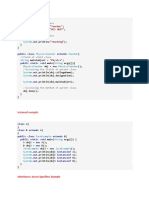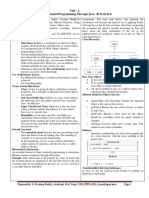0% found this document useful (0 votes)
13 views10 pagesInheritance
The document contains multiple Java programs demonstrating various types of inheritance, including single, multilevel, and hierarchical inheritance, as well as the use of the super keyword for accessing variables and methods. It also covers parameterized constructors and method overriding with the @Override annotation. Additionally, a polymorphism example illustrates how a Person can take on different roles through subclassing.
Uploaded by
BhargaviCopyright
© © All Rights Reserved
We take content rights seriously. If you suspect this is your content, claim it here.
Available Formats
Download as PDF, TXT or read online on Scribd
0% found this document useful (0 votes)
13 views10 pagesInheritance
The document contains multiple Java programs demonstrating various types of inheritance, including single, multilevel, and hierarchical inheritance, as well as the use of the super keyword for accessing variables and methods. It also covers parameterized constructors and method overriding with the @Override annotation. Additionally, a polymorphism example illustrates how a Person can take on different roles through subclassing.
Uploaded by
BhargaviCopyright
© © All Rights Reserved
We take content rights seriously. If you suspect this is your content, claim it here.
Available Formats
Download as PDF, TXT or read online on Scribd
/ 10























































































